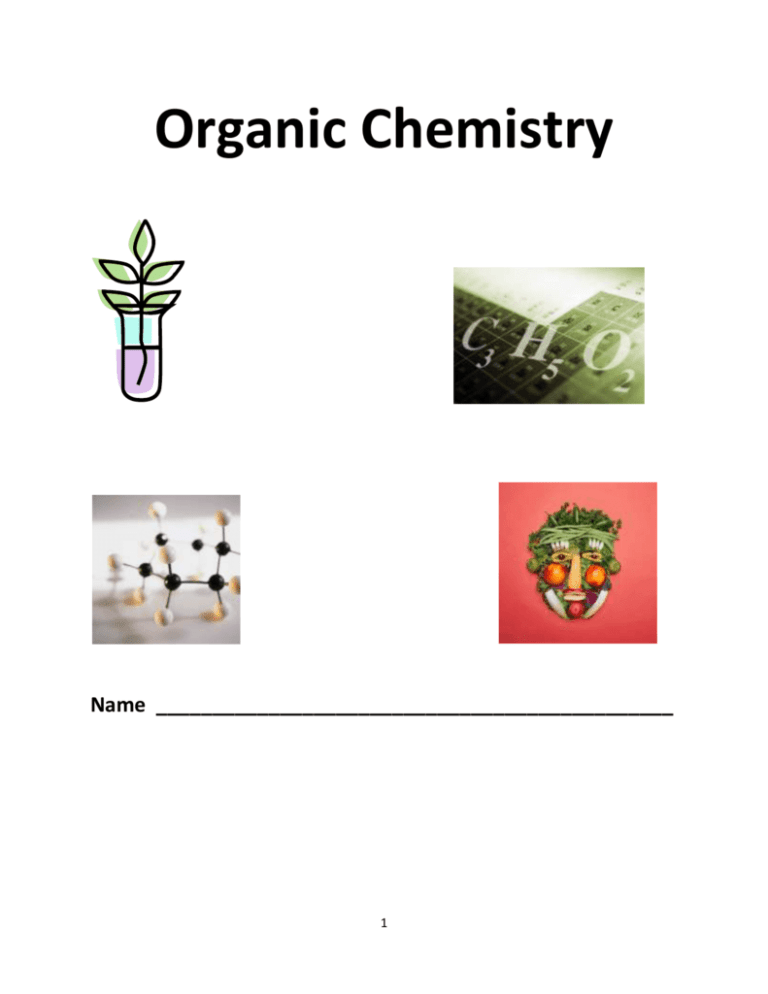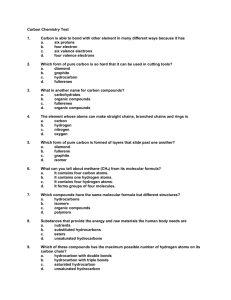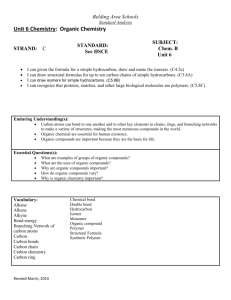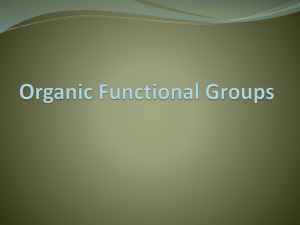Organic Packet - OurTeachersPage.com
advertisement

Organic Chemistry Name ______________________________________________ 1 Content Objectives: 1. Draw structural formulas for alkanes, alkenes, and alkynes containing a maximum of 10 carbon atoms 2. Classify an organic compound based on its structural or condensed structural formula 3. Draw a structural formula with the functional group(s), on the straight chain hydrocarbon, when given the correct IUPAC name for the compound 4. Identify types of organic reactions 5. Determine a missing reactant or product in a balanced equation 6. Make real world connections to: odors (esters), saponification-making soap, polymerizationformation of starches, fermentation-alcohol production, combustion of fossil fuels Key Subject Competencies 1. 2. 3. 4. 5. 6. 7. 8. 9. 10. 11. 12. 13. 14. 15. 16. 17. 18. 19. Explain how bonding occurs between carbon atoms Determine common characteristics of the Alkane family Distinguish among the different families of hydrocarbons Determine common characteristics of the families Use table Q to identify different families of hydrocarbons Use table P to name the members of the different families of hydrocarbon compounds Identify unsaturated organic compounds by the fact that these compounds have double or triple bonds between carbon atoms in a chain Determine the name aliphatic hydrocarbons Name the alkyl radicals Name halogen side chains Use Table R to identify the functional groups for halides, alcohols, ethers, and aldehydes Use Table R to determine the names of different draw ketones, organic acids, esters, amines, and amides? Identify isomers as molecules that have the same molecular formulas but different structural formulas Explain why isomers of molecules have different properties Describe and distinguish between substitution and addition reactions Distinguish between substitution and addition reactions when given samples of each Describe and recognize a polymerization reaction List some natural polymers and synthetic polymers Recognize and distinguish between esterification, fermentation, saponification,and combustion Vocabulary: Addition reaction Alcohol Aldehyde Alkane Alkene Alkyne Amide Amine Amino acid Esterification Ester Ether Fermentation Functional group Hydrocarbon Isomer 2 Ketone Organic acid Organic halide Polymer Polymerization Saponification Saturated/Unsaturated Substitution reaction What is meant by the term Organic? Characteristics of organic compounds Formed as a result almost exclusively of _____________________ bonding Generally ______________________ Generally insoluble in water o usually soluble in nonpolar solvents (other organic compounds) Non-electrolytes ___________________________________ which are weak electrolytes Have low melting points (due to _______________________________________ forces) o The great number of carbons leads to a higher melting point. Have slower reaction rates than inorganic compounds o covalent bonds within organic molecules are strong o activation energies are high o catalysts are often used to increase reaction rates How can we describe Hydrocarbons? Hydrocarbons o Definition - compounds composed of only _______________________________ o There are so many hydrocarbons found in nature; nearly impossible to study all! They are grouped in ____________________________ series. o Homologous series - group of organic compounds with similar properties and related structures (differ from each other by CH3) o 3 Important Homologous Series of Hydrocarbons: _______________________________ _______________________________ _______________________________ Aliphatic - hydrocarbon chains o Saturated - has no bonds that can be broken to add extra hydrogen o Alkanes family of hydrocarbons with all single bonds general formula CnH2n+2 named with suffix "ANE“ Table P – Organic Prefixes As the number of carbons increases, the boiling point increases. Name and draw the first ten Alkanes o Go to table P and look at the prefix for the number of carbons 1 carbon is Meth - All alkanes end in ‘ane’ - methane TAKE OUT PAPER AND DRAW PLEASE 3 What are the Unsaturated Hydrocarbons? Unsaturated - has double or triple bonds that can be broken to add more hydrogen o Alkenes family of hydrocarbons with at least one double bond general formula CnH2n named with suffix "ENE“ Starts with Ethene. Draw the first nine Alkenes - TAKE OUT PAPER AND DRAW PLEASE o Go to table P and look at the prefix for the number of carbons 2 carbons is Eth - All alkenes end in ‘ene’ - ethene o Alkynes family of hydrocarbons with one triple bond general formula CnH2n-2 named with suffix "YNE“ Starts with Ethyne. Draw the first nine Alkynes - TAKE OUT PAPER AND DRAW PLEASE o Go to table P and look at the prefix for the number of carbons 2 carbons is Eth - All alkenes end in ‘yne’ - ethyne With this ring I, get confused? The Benzene Series (Aromatic hydrocarbons) o The benzene series consists of molecules which are cyclic in nature. o The general formula is CnH2n-6. 4 Practice Time 1) Which is the structural formula of ethene? a. c. b. d. 2) Hydrocarbons are compounds that contain a. carbon, only b. carbon and hydrogen, only c. carbon, hydrogen, and oxygen, only d. carbon, hydrogen, oxygen, and nitrogen, only 3) Which formula represents an unsaturated hydrocarbon? a. C2H6 b. C3H8 c. C5H8 d. C6H14 4) Which formula represents an unsaturated hydrocarbon? a. CH2CHCl b. CH3CH2Cl c. CH3CH2CH3 d. CH3CHCH2 5) Which compound is a saturated hydrocarbon? a. CH2CH2 b. CH3CH3 c. CH3CHO d. CH3CH2OH 6) Which element is present in every organic compound? a. carbon b. fluorine c. nitrogen d. oxygen 7) Which element has atoms that can bond with each other to form long chains or rings? a. carbon b. nitrogen c. oxygen d. fluorine 5 8) Which structural formula represents a member of the series of hydrocarbons having the general formula CnH2n-2? c. a. d. b. 9) Which compound is an alkyne? a. C2H2 b. C2H4 c. C4H8 d. C4H10 10) The compound C4H10 belongs to the series of hydrocarbons with the general formula a. CnH2n b. CnH2n+2 c. CnH2n-2 d. CnH2n-6 11) Which formula represents propyne? a. C3H4 b. C3H6 c. C5H8 d. C5H10 12) A carbon-carbon triple bond is found in a molecule of a. butane b. butanone c. butene d. butyne 13) A molecule of a compound contains a total of 10 hydrogen atoms and has the general formula CnH2n+2. Which prefix is used in the name of this compound? a. butb. decc. octd. pent14) Which formula represents a saturated hydrocarbon? a. C2H2 b. C2H4 c. C3H4 d. C3H8 6 15) Which structural formula represents 2-pentyne? c. a. d. b. 16) Which structural formula correctly represents a hydrocarbon molecule? c. a. d. b. 17) Which general formula represents the homologous series of hydrocarbons that includes the compound 1-heptyne? a. CnH2n-6 b. CnH 2n-2 c. CnH2n d. CnH2n+2 18) A double carbon-carbon bond is found in a molecule of a. pentane b. pentene c. pentyne d. pentanol 7 19) Which structural formula represents an unsaturated hydrocarbon? c. a. d. b. 20) Given the structural formula: What is the IUPAC name of this compound? a. propane b. propene c. propanone d. propanal 21) Which hydrocarbon is saturated? a. propene b. ethyne c. butene d. heptanes 22) Which hydrocarbon is a member of the alkane series? c. a. d. b. 8 23) Which compound is a member of the same homologous series as C3H8? a. CH4 b. C4H8 c. C5H8 d. C5H10 24) Which is a saturated hydrocarbon? a. ethene b. ethyne c. propene d. propane How can we name organic compounds? Rule 1: Find the longest continuous chain Rule 2: Assign numbers to each C atom in the longest chain, starting at the end with the attached group. Rule 3: If more than one of the same types of group is attached to the main chain prefixes are used to identify the attached groups. Rule 4: When naming alkenes or alkynes the carbon with the double/triple bond, the carbon number with the double/triple bond must be identified in the name. 9 10 CH2 ─ CH3 | a) CH3─ CH ─CH2─CH ─ CH ─ CH3 | | CH2 CH3 | CH3 b) c) CH3 H \ / C=C / \ H CH2 ─CH3 CH ≡ C─ CH3 d) CH3 -CH2-CH2-CH=CH-CH3 e) CH2=CH-CH2-CH=CH-CH3 f) CH3 – CH2 - C ≡ C- CH2- CH3 How can we represent organic compounds? o Molecular Formula Shows the kind and number of atoms in a compound. Example: CH4 or C2H6 Tells us that there are carbon and hydrogen atoms. For methane, there are 4 hydrogens for 1 carbon atom. o Structural Formula In addition, shows the bonding patterns and two-dimensional view. For example: o Condensed Structural Formula Written structural formula For example: Methane: CH4 Ethane: CH3CH3 o Ball-and-Stick Model Shows a 3D structure of the compound o Space-Filling Model Shows the actual structure of the compound 11 Isomers o When a molecular formula can be represented by more than one structural arrangement o Isomers have the same molecular formula, but different physical and chemical properties. o As the # of carbon atoms increases, so does the # of possible isomers How would you draw the structural formula for a 4 carbon hydrocarbon? Isomer Practice o Draw 3 Isomers for 5 and 6 carbon Alkanes. o Be sure you have the correct number of hydrogens. 12 1. Given a formula representing a compound: Which formula represents an isomer of this compound? 2. 3. 3. 4. 2. Which two compounds have the same empirical formula? 1. C2H2 and C2H4 2. CH2 and C3H8 3. HO and H2O 4. NO2 and N2O4 3. Which compound is an isomer of C4H9OH? 1. C3H7CH3 2. C2H5OC2H5 3. C2H5COOC2H5 4. CH3COOH 4. A characteristic of most organic compounds is that they 1. have low melting points 4. conduct electricity when dissolved in 2. have high melting points water 3. are soluble in water 5. Which structural formula represents a molecule that is not an isomer of pentane? 1. 2. 3. 4. 13 6. All organic compounds must contain the element 1. phosphorus 2. oxygen 3. carbon 4. nitrogen 7. Base your answer to this question on the information below. The formula below represents a hydrocarbon. Which structural formula below shows an isomer of this hydrocarbon? 1. 3. 4. 2. 8. The three isomers of pentane have different 1. formula masses 2. molecular formulas 3. empirical formulas 4. structural formulas 9. The isomers CH3OCH3 and CH3CH2OH differ in 1. molecular formula 2. molecular structure 3. number of atoms 4. formula mass 10. Which two compounds have the same molecular formula but different chemical and physical properties? 1. CH3CH2Cl and CH3CH2Br 2. CH3CHCH2 and CH3CH2CH3 3. CH3CHO and CH3COCH3 4. CH3CH2OH and CH3OCH3 14 11. Which structural formula is incorrect? 1. 3. 2. 4. 12. Which statement explains why the element carbon forms so many compounds? 1. 2. 3. 4. Carbon atoms combine readily with oxygen. Carbon atoms have a very high electronegativity. Carbon readily forms ionic bonds with other carbon atoms. Carbon readily forms covalent bonds with other carbon atoms. 13. Compared to the rate of inorganic reactions, the rate of organic reactions generally is 1. 2. 3. 4. slower because organic particles are ions slower because organic particles contain covalent bonds faster because organic particles are ions faster because organic particles contain covalent bonds 14. The compounds CH3OCH3 and CH3CH2OH are isomers of each other. These two compounds must have the same 1. density 2. reactivity 3. melting point 4. molecular formula 15. In a molecule of CH4, the hydrogen atoms are spatially orientated toward the corners of a regular 1. pyramid 2. tetrahedron 3. square 4. rectangle 16. The compounds C2H4 and C4H8 have the same 1. freezing point at standard pressure 2. boiling point at standard pressure 3. molecular formula 4. empirical formula 15 17. Which formula represents an unsaturated hydrocarbon? 1. 3. 2. 4. 18. Which is an isomer of CH3CH2CH2COOH? 1. CH3CH2OCH2CH3 2. CH3CH2CH2OCH3 3. CH3CH2CH2CH2OH 4. CH3COOCH2CH3 19. Two substances have different physical and chemical properties. Both substances have molecules that contain two carbon atoms, one oxygen atom, and six hydrogen atoms. These two substances must be 1. isomers of each other 3. the same compound 2. isotopes of each other 4. the same hydrocarbon 20. What is the total number of valence electrons in a carbon atom in the ground state? 1. 6 2. 2 3. 12 4. 4 21. The isomers butane and methylpropane differ in their: 1. molecular formulas 2. structural formulas 3. total number of atoms per molecule 4. total number of bonds per molecule 22. Which compound is an isomer of pentane? 1. butane 2. propane 3. methyl butane 4. methyl propane 23. Which pair of compounds are isomers? 1. NO2 and N2O4 2. P2O5 and P4O10 3. HCOOH and CH3COOH 4. CH3OCH3 and C2H5OH 16 What are the various Functional Groups? o Atoms or groups of atoms that replace hydrogen atoms in a hydrocarbon. o This will form new compounds? o They have distinct physical and chemical properties. o There are 9 functional groups o All found on Table R! 1. Halides A Halogen (F, Cl, Br, or I) replaces a hydrogen on a hydrocarbon. o Used as organic solvents o General Formula: R-X (X= Halogen & R= Alkyl group) o Add fluoro for F Designate the location of the halide with 1,2 etc o Chloro for Cl o Bromo for Br o Iodo for I 2. Alcohols Organic compounds in which one or more hydrogen atoms are replaced by an –OH. -OH group is called a hydroxyl group. NOT A BASE! They are nonelectrolytes (Do not form ions in solution). Polar substances General Formula: R-OH Naming: Position of OH group must be assigned & -ANE ending changes to –OL. Classification of Alcohols There are primary, secondary, and tertiary carbon atoms: Primary Carbon: Attached to one carbon only Secondary: Attached to two carbon atoms Tertiary: Attached to three carbon atoms. 3. Aldehydes Organic compounds in which a carbonyl group (C=O) is found on the end carbon (a primary carbon): Naming: Substitute –AL in place of final –E of alkane name. 17 4. Ketones C=O group is on the inside of a hydrocarbon: Naming: Substitute –ONE in place of final –E of alkane name. 5. Ethers Two carbon chains are joined together by an oxygen atom: Naming: name the alkyl groups and add ether at the end. General Formula: R-O-R 6. Organic Acids Organic compounds that have a Carboxyl group (-COOH): Naming: Substitute –OIC ACID in place of final –E in alkane name. Ethanoic acid= Acetic acid 7. Esters Have strong aromas; for example, flavorings in bananas, wintergreen, oranges. The fine smell of esters 8. Amines Formed when one or more of the hydrogen’s in ammonia is replaced by an alkyl group: Naming: Substitute –AMINE in place of final –E of alkane name. 9. Amides Formed by the combination of 2 amino acids: Form proteins Naming: Replace final –E with -AMIDE 18







